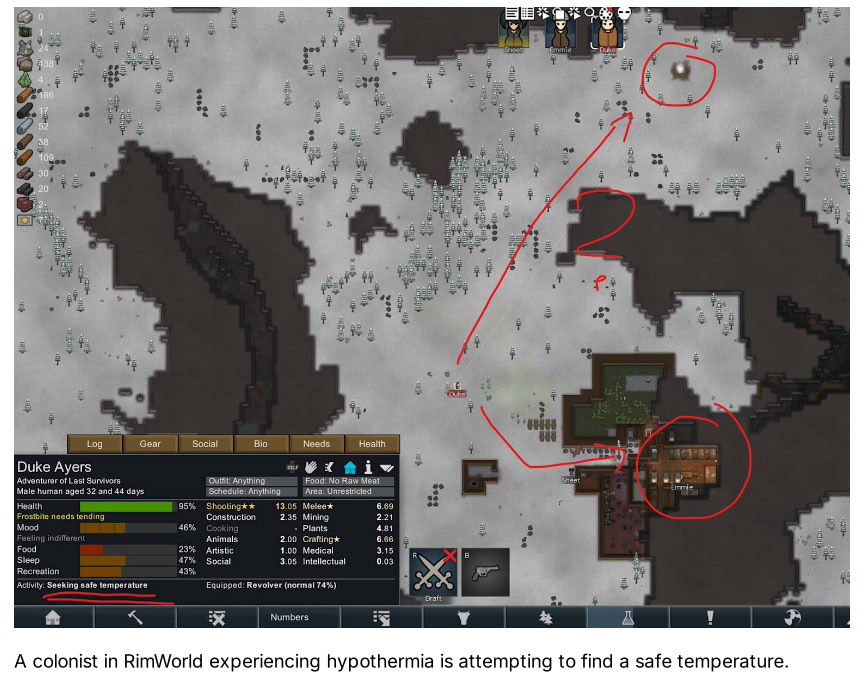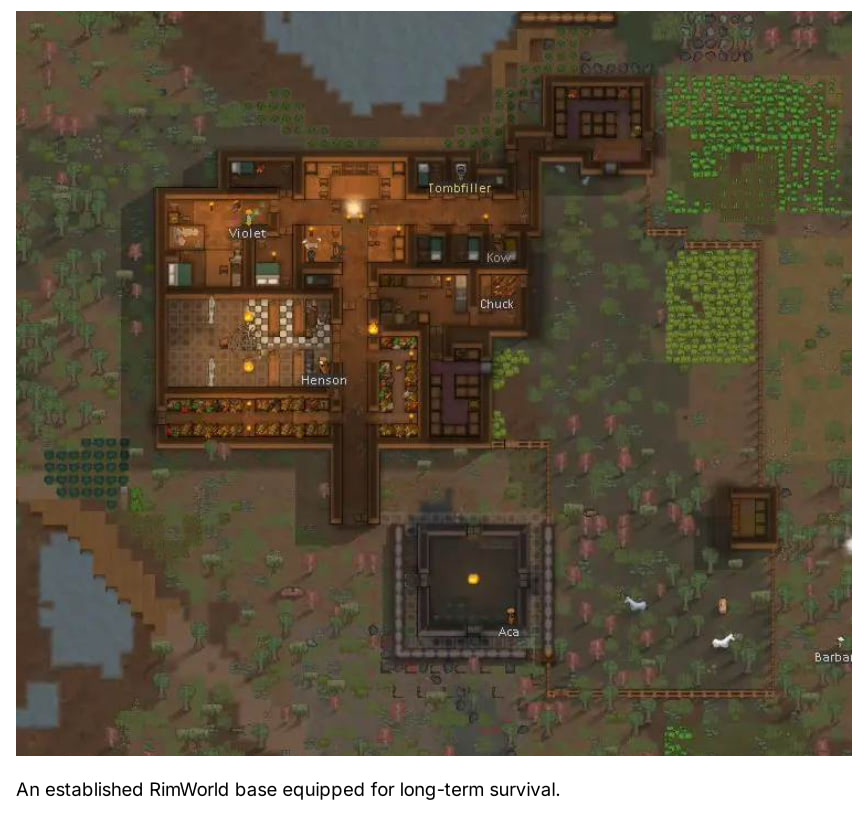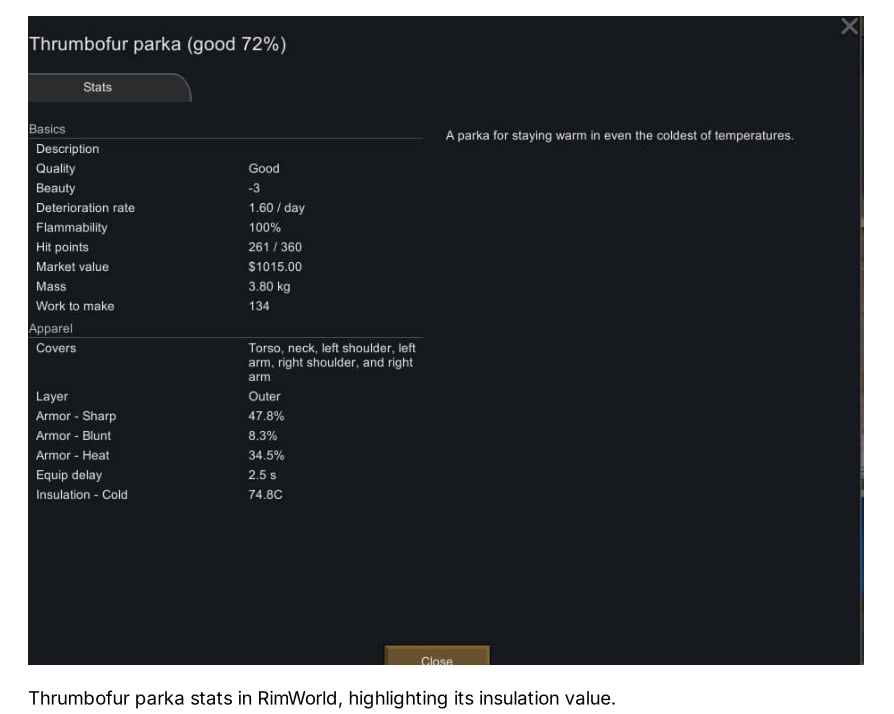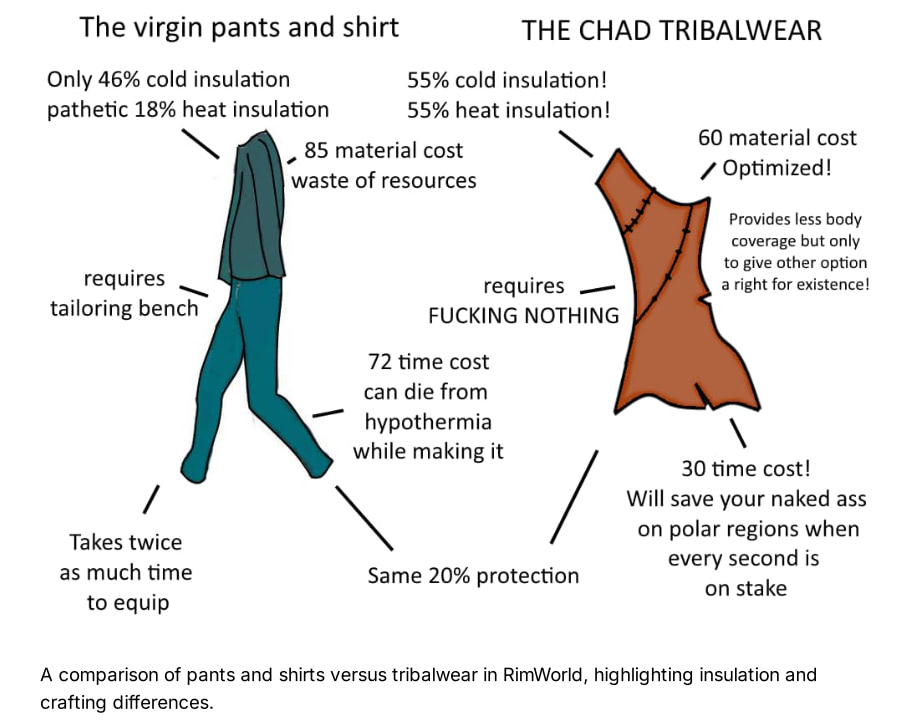Beat the Freeze: RimWorld Warm Gear That Actually Saves Lives
Navigation
🔥 Quick-Start: Warm Clothes in a Hurry
If you're on the brink of freezing, here's the TL;DR quick-start to get your colonists warm:
- Build a Heat Source Immediately: Get a campfire or heater going in an enclosed space. A small room with a campfire can hover around 20 °C indoors even if it's below freezing outside. This buys you time and a warm refuge for pawns without proper clothes. For advanced heating strategies and temperature control systems, see our airlock and temperature control guide.
- Craft or Grab a Parka ASAP: Parkas are your best friend in cold biomes – they dramatically extend a pawn's safe temperature range (a normal muffalo wool parka can keep a pawn comfy down to about –55 °C!). If you have the materials and research, craft parkas and tuques (winter hats) at a tailoring bench.
- Layer Up Whatever You Have: Until you get parkas, layer your colonists with every available clothing slot. That means a shirt + pants + jacket (or duster) + hat. For example, a pawn in a wool button-down shirt, wool pants, and a leather jacket might weather moderate cold.
- Use Sleeping Spots by Fires/Geysers: When night falls, make your colonists sleep warm. If you have a steam geyser, consider making a tiny room over it or near it.
- Monitor the "Comfortable Temperature" Range: Select a pawn and check their Gear tab – it shows their safe temperature range (e.g. –30 °C to +26 °C). Pay attention to that lower number.
Emergency Tip: Even a poor-quality or tainted parka is better than nothing in an emergency. The -3 mood debuff from wearing a dead person's clothes is better than hypothermia!

Emergency shelter with campfire heating - your first line of defense against hypothermia
🧵 Best Materials for Cold Protection
Different textile materials provide varying degrees of cold insulation. Here are the top contenders for keeping your colonists warm:
| Material | Cold Insulation Bonus | Source | Notes |
|---|---|---|---|
| Guinea Pig Fur | +38 °C | Guinea Pig (animal) | Top insulator but rare/hard to get in bulk |
| Thrumbofur | +34 °C | Thrumbo (rare animal) | Excellent armor values too; end-game material |
| Megasloth Wool | +34 °C | Megasloth (animal) | Great insulation but can't be farmed easily |
| Chinchilla Fur | +30 °C | Chinchilla (animal) | Small animals, need many for a parka |
| Alpaca Wool | +30 °C | Alpaca (farmable) | Excellent all-rounder, also good heat resistance (+16°C) |
| Heavy Fur | +30 °C | Arctic animals (fox, wolf) | Good mid-game option from hunting |
| Sheep Wool | +26 °C | Sheep (farmable) | Easily farmed, good mid-tier option |
| Muffalo Wool | +20 °C | Muffalo (farmable) | Commonly available, decent insulation |
| Devilstrand | +20 °C | Grown (mushroom) | Excellent protection stats, decent insulation |
| Plainleather | +16 °C | Common animals | Average insulation, readily available |
| Cloth | +16 °C | Grown (cotton) | Basic insulation, easy to produce |
| Human Leather | +12 °C | Human corpses | Poor insulation, causes mood debuffs for non-cannibals |
Pro Tip: Quality matters! A Legendary heavy fur parka can out-insulate a normal thrumbofur one due to the 1.8x quality multiplier. A skilled crafter (15+ skill) significantly improves your chances of higher quality apparel.

Comparing different materials - notice how wool and fur provide superior cold insulation
🥶 Early-Game Survival in Cold Biomes
Early game in a cold biome (think Ice Sheet, Tundra, Boreal Forest in winter) is a race against time and temperature. Your starting survivors often have inadequate clothing – e.g. a tribal start might spawn with just tribalwear, or a crashlanded crew might have one jacket between them.
1. Secure a Warm Shelter
Before even worrying about parkas, make sure you have at least one heated room. Build a small hut (the smaller, the easier to heat) and get a campfire or heater running inside. A single campfire can heat a tiny room by ~20-30°C above outside temp.
2. Rush Basic Clothing Production
If you're a tribal start, research Complex Clothing immediately – you can't craft parkas or even pants until you have that. If you're crashlanded, you start with that tech, so set up a hand tailoring bench on day one if possible.
3. Use Any Available Materials
What if you have no wool or good leather? Use whatever you've got. Leather parkas from creatures like deer or muffalo are decent. Even cloth parkas help a lot – a normal cloth parka gives around +18°C cold protection, which can be the difference between mild shivers and serious hypothermia.
Early Game Emergency Shelter

Early game tailoring bench setup - essential for survival in cold biomes
- Build a tiny 3x3 or 4x4 room
- Place a campfire in the middle
- Add sleeping spots around it
- Double-wall if materials allow
- Use a steam geyser for free heat if available
4. Warm Headgear Matters
It's not just parkas – the head is a vital heat-loss point. Craft tuques (woolen beanies) for everyone. A tuque can add around +6 to +12°C to comfortable cold, depending on material. For example, a muffalo wool tuque can provide roughly +12°C cold insulation by itself.
5. Leverage Fire and Geysers
Make use of natural heat. If there's a steam geyser on your map, you can build a quick shack on top of it and basically get a free heater. Be cautious though: geysers are very hot (they can heat a small room above 30 °C easily).
6. Plan the First Winter's Food vs. Warmth Balance
Often in early cold-game, you face a choice: spend time gathering food or securing clothing. Remember, food won't matter if your colonists freeze to death. Consider hunting muffalo or megasloths first – they provide both food and great leather for clothes.
Example Early-Game Scenario
You have three tribal colonists on a tundra. It's mid-fall and nights are hitting –10 °C, none of you have parkas. You rush to research Complex Clothing while burning through wood for campfires. A trader comes by and luck! they're selling a poor cloth parka. You buy it and give it to your cook who has to step out to butcher animals in an unheated shed – now she's safe to work outside down to about –25 °C. The others rotate tending the fire and building a tiny workshop. A maddened muffalo attacks but you down it – yielding 60 bluefur. That plus some leftover rabbit leather lets you craft a second parka. By the time the first snow falls, two colonists have parkas and the third wears two layers of tribalwear. It's not elegant, but no one dies of hypothermia. You've survived the hardest part. 👍
👕 Mid-Game Strategies: Expanding Your Wardrobe
Once you're past the initial survival scramble, the mid-game is about securing a sustainable supply of warm apparel and balancing warmth with other needs like protection, speed, and mood.
1. Establish Clothing Production
By mid-game, you should have a dedicated tailor (or two) and possibly an electric tailoring bench for faster production. Set up a bill to always keep a few parkas in stock (the "Do until X" with X= say 2 parkas above what's worn).
The mid-game is also a good time to start producing Devilstrand if you have the research and a growing season or hydroponics.
2. Ranch Animals for Wool
If your biome permits, mid-game is when you can domesticate livestock specifically for warm textiles. Muffalo, alpacas, sheep, llamas – these are walking wool factories.
One mid-game strategy: trade for a breeding pair of sheep or alpacas from a caravan. They'll multiply and soon you'll be swimming in wool.
3. Upgrade Existing Apparel
In mid-game you'll have the time and resources to refine your colonists' outfits. Did someone survive winter with a patchwork of cloth and plainleather clothes?
As you get better materials, recraft those items. For instance, if you obtain a bunch of heavy fur, consider making dusters or cloaks for your pawns to wear when a parka is overkill.
4. Trade and Quest for Exotic Materials
By now, you might get quests or trade opportunities that yield thrumbofur or hyperweave or other exotic textiles. Thrumbofur in particular is god-tier for cold apparel: a thrumbofur parka can push insulation to absurd levels (a normal thrumbofur parka gives ~ –68 °C comfort range, and legendary thrumbofur parka over –100 °C!).
5. Balance Warmth vs Combat Gear
By mid-game you probably have access to Flak armor (vests, jackets, pants) and maybe even some pieces of Plate armor or Recon armor. These offer protection but at the cost of some movement and very little insulation. A crucial mid-game combo is: Flak Vest + Parka.
Armor Tip: A flak vest (worn on middle layer) provides torso protection, while a parka (outer layer) provides the insulation. They don't conflict, and together your pawn is both armored and warm.
6. Improve Pawn Mood and Appearance
By mid-game, you can address the side effects of bundling up. Colonists can get the "Wearing worn-out apparel" debuff if any clothing is under 50% HP. To avoid this, periodically make new clothes and force pawns to swap out of tattered parkas. Set your Outfit settings to disallow apparel below 51% durability.

Mid-game clothing production facility with organized storage and quality materials
❄️ Late-Game & Advanced Cold-Climate Tactics
In late-game, your colony is well-established. You likely have high-tech resources, maybe some power armor, perhaps the Royalty DLC's fancy apparel, or even gene-tailored colonists (if using Biotech). The challenges shift from simply surviving cold to optimizing for cold while maintaining maximum combat effectiveness and colony wealth.
1. Power Armor vs. Parkas – Hybrid Approach
Late game often introduces Marine armor, Recon armor, and other advanced gear. These offer superior protection but poor insulation (power armor is metal and seals the pawn, but not designed as a coat).
One strategy is situational gear swapping: keep parkas on for routine tasks, but have pawns swap into power armor when a raid or dangerous combat is imminent. You can achieve this by stockpiling armor near your defensive positions.
2. Late-Game Heating Infrastructure
By late game you should have redundant heating and temperature control. For example, use multiple heaters per room, have backup power for heaters (so a Zzztt or solar flare doesn't leave you freezing). You can create heated pathways or greenhouses that connect buildings, so pawns are rarely exposed directly to the outside.
Thriving Ice Base

Advanced late-game base with sophisticated temperature control and high-quality warm clothing
Late-Game Essentials:
- Redundant power systems
- Double-walled structures
- Heated connecting corridors
- High-quality thrumbofur/wool parkas
- Multiple stockpiles of warm clothes
3. Managing Caravans and Travel
Late game is when you might venture out for quests or even to launch the ship (if going for the win) which may involve traveling to a distant ship site. Traveling in extreme cold presents unique challenges. Always outfit caravans with the best cold-weather gear – even if at home your soldiers wear armor, you should send them out in parkas and warm clothes.
4. Utilizing New Technologies/Abilities
If you have the Biotech expansion, you might have genes that help with cold. For example, some xenotypes have Furskin or Cold inclined genes making them naturally resistant to cold. A colonist with the Yttakin furry gene or a "Cold tolerant" gene can handle about –10 °C more comfortably than a normal human. Learn more about optimizing colonist traits and abilities in our Prepare Carefully guide.
5. Children and Warm Clothes
By late game, you might have children in the colony (either naturally or via growth vats, if Biotech). Remember: children cannot wear adult apparel until they hit teen years. In cold biomes, make sure to craft Kids' parkas and kids' tuques at your tailoring bench. For comprehensive colony management strategies including handling multiple generations, check our optimal colony layout guide.
6. Style and Luxury
In late game you can afford to dress pawns in stylish apparel without compromising survival. For example, you might give your leader a Thrumbofur bowler hat and an Arctic fox fur cape (from Royalty DLC) for roleplay reasons.
7. Overcoming Extreme Biomes
If you're playing on Sea Ice or an Ice Sheet year-round, late game might still be –50 °C in summer. Here you use all the tricks: double-walled, heated base, only go outside in pairs (so they can rescue each other if one collapses), use transport pods for anything beyond a few tiles of travel, and keep everyone in top-tier parkas all the time.
❓ FAQ: Frosty Questions and Hot Answers
📜 Patch-History (Warm Clothing Changes)
Alpha 8 (Dec 2014)
"Winter is Coming" update: Parkas and Tuques added to the game, along with the cold biomes (Tundra, Ice Sheet) and hypothermia mechanics. This was the first introduction of dedicated warm clothes in RimWorld's history.
Beta 19/1.0 (Oct 2018)
Parka balancing: Removed the work speed and movement speed penalties from parkas. Up until this point, wearing a parka made pawns work 20% slower (to simulate bulkiness) and move –5% slower. The devs removed these penalties, making parkas strictly beneficial for insulation with no work trade-off.
Ideology DLC (July 2021)
Introduced Outfit Styles and dye system. Colonists developed style preferences (e.g. spikecore, morbid, etc.), and new apparel like Burkas and Hoods were added. Warm clothes can now be styled to fit an ideoligion.
Royalty DLC (Feb 2020)
Added noble apparel like the Cape and Prestige armor. Capes have about 0.8 insulation factor (like a fancy duster) and can be made of wool – a fur cape can keep a baron warm in style.
Biotech DLC (Oct 2022)
Introduced Children and child-sized apparel. Now you must craft Kid Parkas, Kid Tribalwear, Kid Cowboy hats, etc., for your little ones – adult parkas no longer magically resize. Also added genes like Cold Tolerant and Furskin.
Update 1.5 (Oct 2024)
A small update primarily focused on performance and polish. Notably, it improved the performance of the "Need warm clothes" alert when you have massive amounts of clothing in stockpiles.